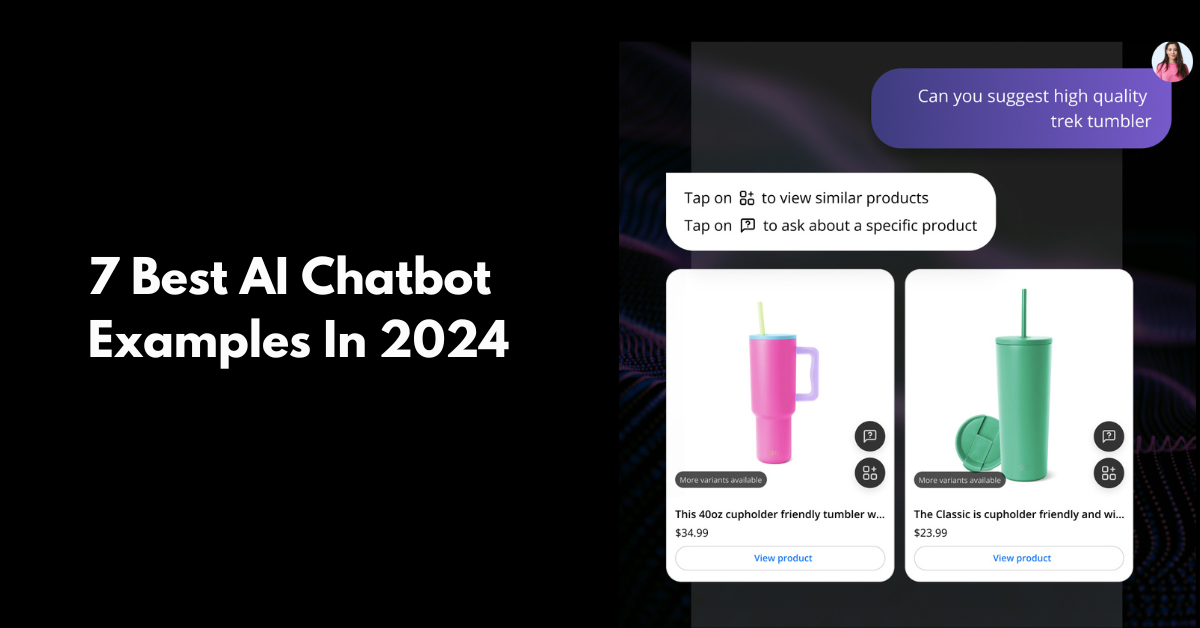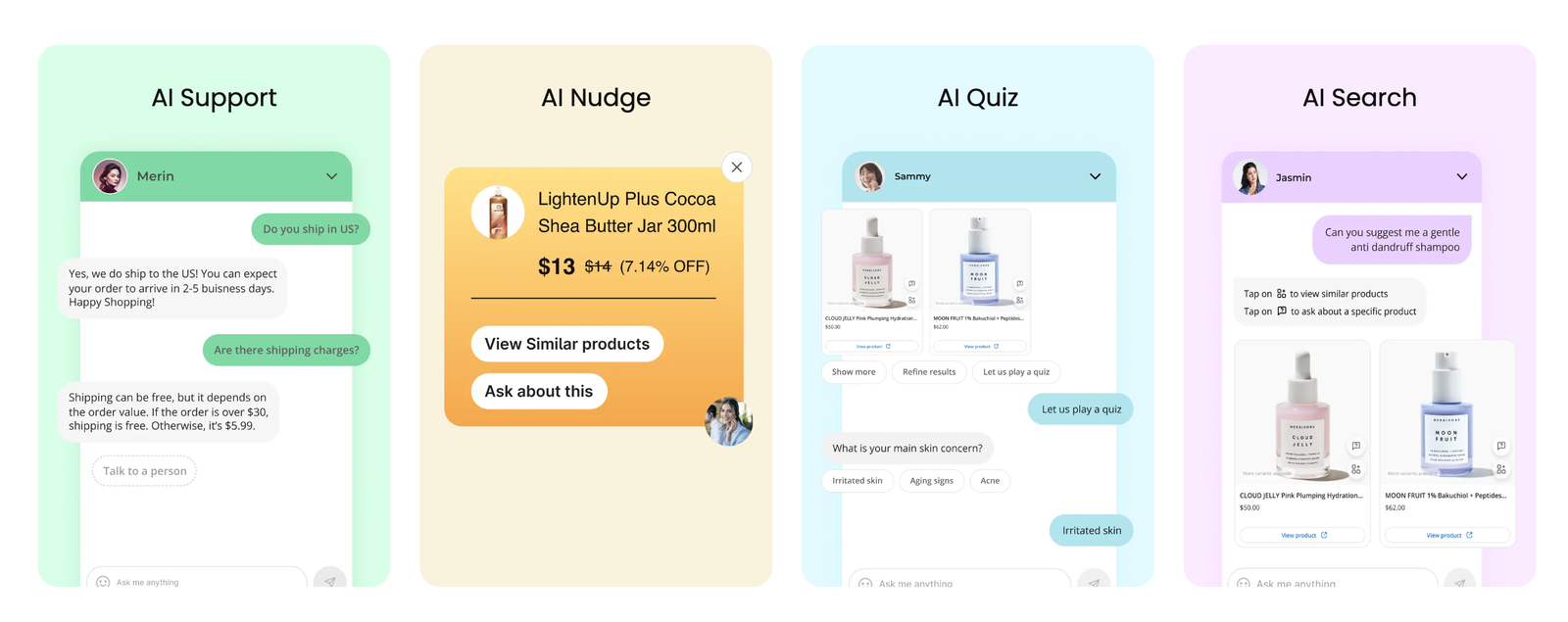7 Best AI Chatbot Examples In 2024

AI chatbots have become integral to enhancing customer service across various industries, dramatically improving response times and satisfaction levels. A study indicates that businesses using AI chatbots have seen customer inquiries resolved up to 80% faster compared to traditional methods. This blog will showcase seven outstanding AI chatbot examples that have set the standard for innovation and efficiency in customer interaction. Each example illustrates how these tools not only meet but often exceed customer expectations, streamline operations, and help businesses keep pace with the growing demand for instant, round-the-clock communication.
7 Best AI Chatbot Examples
Here is the list of 7 generative AI chatbot examples:
Manifest AI

Manifest AI stands out as a revolutionary AI shopping assistant, designed to enrich the online shopping experience. Here’s a closer look at its features and how it enhances customer interactions:
Features:
- AI Search: Empowers users with smart search capabilities, enabling them to find products quickly and accurately based on their queries and preferences.
- AI Nudge: Utilizes behavioral cues to suggest relevant products and deals, encouraging customers to explore items they might not have otherwise considered.
- AI Support: Provides instant, 24/7 customer support, answering queries, offering help, and solving common issues without human intervention.
- AI Quiz: Engages customers with interactive quizzes to better understand their preferences and recommend products tailored to their needs.
Pros:
- Enhances user engagement through personalized interactions.
- Increases sales conversion rates with targeted product suggestions.
- Reduces workload on customer service teams with automated support.
Cons:
- Requires continuous data input and training to maintain accuracy.
- May face user resistance from those preferring human interaction.
ChatInsight AI

ChatInsight AI is an advanced chatbot designed to enhance customer interactions through intelligent, automated responses. It leverages cutting-edge AI to understand and process customer queries, providing accurate and context-aware solutions.
Features:
- Natural Language Processing (NLP): Understands and interprets human language with high accuracy.
- Customizable Workflows: Allows businesses to tailor conversation flows to meet specific needs.
- Integration Capabilities: Seamlessly integrates with existing CRM and ERP systems to provide consistent information.
Pros:
- Efficiency: Streamlines customer service by handling multiple inquiries simultaneously, reducing wait times.
- Availability: Offers 24/7 customer support, ensuring that help is always available.
- Data Insights: Generates valuable insights from customer interactions, aiding in decision-making and strategy refinement.
Cons:
- Complex Setup: Requires initial customization and setup, which may need technical expertise.
- Limited Understanding: While advanced, it may still misinterpret complex queries or subtleties of human language, leading to potential customer frustration.
OpenAI ChatGPT

OpenAI's ChatGPT is an advanced AI chatbot built on the GPT (Generative Pre-trained Transformer) architecture. It is designed to understand and generate human-like text based on the input it receives, enabling dynamic and nuanced conversations.
Features:
- Natural Language Understanding: ChatGPT excels in interpreting complex language nuances and responding appropriately.
- Contextual Awareness: It can maintain the context of a conversation over multiple exchanges, making interactions feel more coherent and natural.
- Wide-Ranging Knowledge: ChatGPT has been trained on a diverse dataset, allowing it to converse intelligently on a vast array of topics.
Pros:
- Versatility: Effective in various applications, from customer service to educational aids.
- Efficiency: Automates interactions, reducing the need for human input in resolving standard inquiries.
Cons:
- Dependence on Training Data: Its responses are limited to the scope of its training data, which can occasionally produce irrelevant or unexpected answers.
- Lack of Emotional Intelligence: While adept at processing text, it cannot understand or convey emotions as a human would.
Google Bard

Google Bard is a conversational AI developed by Google, designed to compete with advanced AI models like ChatGPT. Built on Google's Language Model for Dialogue Applications (LaMDA), Bard aims to provide detailed and nuanced responses in discussions ranging from simple inquiries to complex topics.
Features:
- Contextual Understanding: Bard leverages Google's extensive data to understand and generate responses based on current events and broad knowledge areas.
- Multifunctional Interaction: Capable of answering questions, suggesting ideas, and explaining complex subjects in an accessible manner.
Pros:
- Integration with Google Services: Seamlessly pulls information from various Google services, offering updated and reliable data.
- Scalability: Benefits from Google’s infrastructure for consistent performance even under high demand.
Cons:
- Data Privacy Concerns: As with many AI services that integrate deeply with personal data, users may have concerns about privacy and data usage.
- Reliance on the Internet: Requires an active internet connection to access the latest information and function effectively.
Bing AI

Bing AI is an one of the most advanced customer service chatbot examples developed by Microsoft, integrated into the Bing search engine. It leverages artificial intelligence to enhance user interactions by providing more intuitive and responsive search experiences.
Features:
- Contextual Understanding: Bing AI can understand and retain the context of a conversation, allowing it to provide relevant and accurate responses.
- Multimodal Capabilities: It supports not just text but also visual content, helping users by answering queries with images and interactive content.
- Integration: Seamlessly integrates with other Microsoft products, enhancing productivity and providing a unified experience across platforms.
Pros:
- Enhanced User Engagement: Offers personalized responses, improving user engagement with the search engine.
- Efficiency: Quickly provides answers, saving users time compared to traditional search methods.
- User-Friendly Interface: Easy to use and accessible directly from the Bing search bar.
Cons:
- Dependence on Data: Performance heavily relies on the quality and quantity of data it has been trained on.
- Privacy Concerns: As with many AI applications, there are concerns about data privacy and how user information is handled and stored.
- Limited to Bing: Its usefulness is confined to the Bing ecosystem, which might not be the primary choice for all users.
Amazon Lex

Amazon Lex is a powerful customer service chatbot example for building conversational interfaces into any application using voice and text. Developed by Amazon Web Services (AWS), Lex provides the advanced deep learning functionalities of automatic speech recognition (ASR) and natural language understanding (NLU) to recognize the intent behind the text and to create a natural, conversational user experience.
Features:
- Ease of Integration: Lex integrates seamlessly with AWS Lambda, allowing developers to execute logic or backend services based on user interactions.
- Multi-Platform Compatibility: It supports integration across multiple platforms, including mobile devices and web applications.
- Scalability: Being a managed service, it scales automatically with the application demand.
Pros:
- Highly Customizable: Developers can define precise conversation flows, manage state, and maintain context.
- Supports Rich Formatting: It can handle and parse various data formats and integrate with other AWS services for a robust solution.
Cons:
- Complexity: New users may find it challenging to navigate the initial learning curve.
- Cost: While it offers a pay-as-you-go pricing model, costs can escalate with increased usage.
Writesonic

Writesonic is one of the best AI-powered chatbots designed primarily for content creation, but it also offers functionalities that can be extended to chatbot applications, especially in generating human-like text for customer interactions.
Features:
- Text Generation: Utilizes advanced AI to generate text that is coherent and contextually relevant, ideal for crafting responses in chatbot applications.
- Multilingual Support: Capable of generating content in multiple languages, making it suitable for global businesses.
- Integration Capabilities: Can be integrated into chatbot platforms to provide dynamic responses based on user inputs.
Pros:
- High-Quality Content: Produces well-structured and contextually appropriate outputs that can mimic human conversational patterns.
- Efficiency: Speeds up the response time of chatbots, providing immediate assistance to users.
- Scalability: Can handle a large volume of queries simultaneously, supporting businesses as they grow.
Cons:
- Dependence on Inputs: The quality of the output heavily depends on the quality of the input data; poor inputs can lead to irrelevant responses.
- Limited Emotional Intelligence: While proficient in generating text, it lacks a nuanced understanding of human emotions compared to more specialized chatbots.
Conclusion
The seven AI chatbot examples highlighted in 2024 demonstrate the vast capabilities and diversity of AI technology in enhancing customer interactions. From streamlining communication to providing instant, tailored responses, these chatbots significantly improve the efficiency and effectiveness of customer service operations. As technology continues to evolve, integrating AI chatbots becomes an increasingly essential strategy for businesses aiming to meet modern consumer expectations and maintain a competitive edge in the digital marketplace.

.png)
